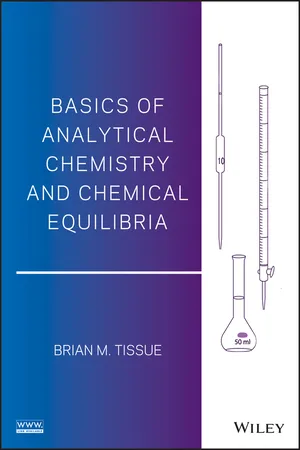Chemistry
Buffers
Buffers are solutions that resist changes in pH when an acid or base is added. They are typically composed of a weak acid and its conjugate base, or a weak base and its conjugate acid. Buffers play a crucial role in maintaining the stability of pH in various chemical and biological processes.
Written by Perlego with AI-assistance
Related key terms
Related key terms
1 of 4
Related key terms
1 of 3
9 Key excerpts on "Buffers"
- No longer available |Learn more
- Steven Boone, Drew H. Wolfe(Authors)
- 2011(Publication Date)
- Collins Reference(Publisher)
CHAPTER 17Aqueous Equilibria: Buffers, Titrations, Solubility, and Complex Ion Equilibria
I n this chapter, our discussion of acids and bases continues by considering buffer solutions, those that resist changes in the pH, and titrations, volumetric procedures in which unknown acid or base solutions are neutralized with known base or acid solutions. Additionally, solubility and complex ion equilibria will be discussed. A solubility equilibrium establishes between undissolved solutes and their dissolved ions. Complex ion equilibria establish between coordination complexes and their ions.17.1 BUFFER SOLUTIONSSolutions that contain both an acid and its conjugate base, or a base and its conjugate acid in sufficient quantity are called buffer solutions. The Nature of Buffer Solutions Buffer solutions maintain a nearly constant pH despite the addition of small amounts of either acids or bases. In other words, buffer solutions resist changes in pH. Components of a Buffer SolutionIf an acid is added to a buffer solution, it must have a basic component to neutralize the acid, and if a base is added to a buffer solution, it must have an acidic component to neutralize the base. Hence, buffer solutions are prepared by mixing either a weak acid and its conjugate base, or a weak base and its conjugate acid.Buffering Action: Adding Acid to a Buffer SolutionTo understand how buffer solutions maintain a constant pH, let’s consider a buffer prepared by mixing equimolar amounts of the weak acid acetic acid, HC2 H3 O2 , and the sodium salt of its conjugate base, sodium acetate, NaC2 H3 O2 . The net ionic equation for the equilibrium that establishes in this buffer solution is as follows.The Na+ ion from the sodium acetate is present as a spectator ion. If a small amount of a strong acid such as HC1 is added to this buffer solution, the resulting H+ ions shift the equilibrium to the left. The net result of adding the HC1(aq) is to decrease the acetate ion concentration and increase the acetic acid concentration. Almost all the added H+ - No longer available |Learn more
- Brian M. Tissue(Author)
- 2013(Publication Date)
- Wiley(Publisher)
Chapter 6: Buffer Solutions and Polyprotic Acids
Learning Outcomes- Identify buffer solutions and predict p[ ] using the Henderson–Hasselbalch equation.
- Use alpha fraction plots to predict the dominant form of a weak acid as a function of pH.
- Describe the regions of a weak acid titration curve and calculate analyte concentration.
- Identify polyprotic acids and determine the limiting reagent in neutralization reactions.
- Predict p[ ] for different forms of a polyprotic weak acid.
6.1 Buffer Solutions
A buffer in chemistry is anything that counteracts a change to a chemical system. A buffer will be added to a test portion to control one or more aspects of the solution chemistry that might affect a measurement. In redox chemistry, a “redox buffer” can maintain one or more species in a certain oxidation state. Analytical methods for iron will often use a reducing agent, for example, hydroxylamine in the Fe-phenanthroline practice exercise in Chapter 4, as a reagent to retain the iron in the Fe form. A pH buffer is a solution that can maintain a nearly constant pH when diluted or when a small amount of strong acid or strong base is added. A buffer solution consists of a mixture of a weak acid and its conjugate base. Describing a buffer as a weak base and its conjugate acid is equivalent. As many analytes and reagents have acidic or basic groups, acid–base Buffers are common in analytical applications to control the solution chemistry. You will see from the examples in the chapter that buffer systems also exist in many environmental and biological systems.How can we make a pH buffer? There are several ways to produce a mixture of a weak acid and its conjugate base:- Mix a weak acid and a salt of its conjugate base in solution.
- Mix a weak acid and enough strong base to neutralize some of the weak acid.
- Mix a weak base and enough strong acid to neutralize some of the weak base.
Any of these procedures will result in a solution that contains a weak acid and its conjugate base. The last two cases are limiting reagent calculations, with the strong base or strong acid being the limiting reagent. Adding excess strong base to a weak acid, or excess strong acid to a weak base, will not produce buffer solutions. The pH response of a buffer solution is illustrated in the following examples. - eBook - ePub
- Professor Rob Beynon, J Easterby(Authors)
- 2004(Publication Date)
- Taylor & Francis(Publisher)
Chapter 2 , but these need not concern us here.◊ Nearly all pH Buffers are weak acids or bases.Notice that the weak acid can be neutral (acetic acid) or carry a positive (TrisH+ ) or negative (phosphate1– ) charge. As we develop the theory of Buffers, it will become clear that these charges on the buffer species have important consequences.2. Weak acids and bases resist pH changesA buffer is able to resist changes in pH because it exists in an equilibrium between a form that has a hydrogen ion bound (conjugate acid, protonated) and a form that has lost its hydrogen ion (conjugate base, deprotonated). For the simple example of acetic acid, the equation is:CH 3COOH ⇌CH 3COO −+H +Here, the protonated form is acetic acid, with a net charge of zero, whereas the deprotonated form (acetate) has a charge of −1. The two species are in equilibrium, and this equilibrium, in common with all equilibria, can be displaced by addition of one component.Consider a solution that contains equal amounts of acetic acid and acetate ions (10 mM acetic acid, 10 mM sodium acetate, for example). If we were to add a strong acid, such as HCl, to this solution, the added H+ would displace the equilibrium to the left. Binding of H+ to CH3 COO– ‘mops up’ the added protons (Figure 3.1 ). Electrical neutrality is preserved because every H+ that reacts with a CH3 COO– anion to form the neutral CH3 COOH leaves behind a chloride (Cl– ) anion in its place. Add a strong base, such as sodium hydroxide, and the OH- ion would react with the H+ and displace the equilibrium to the right. Electrical neutrality in the solution is sustained because for every CH3 COOH that is converted to CH3 COO– , a corresponding Na+ - eBook - ePub
Chemistry
Concepts and Problems, A Self-Teaching Guide
- Richard Post, Chad Snyder, Clifford C. Houk(Authors)
- 2020(Publication Date)
- Jossey-Bass(Publisher)
+ concentration), creating a greater than normal acidity. Electrolyte balance inside and outside the cells of our body is also pH dependent. To maintain the proper balance requires a carefully regulated system wherein the pH of the system remains virtually constant within very specific limits. We now discuss this system that is so prevalent in our bodies and that is extensively used in commercial processes to maintain a constant pH.BUFFER SOLUTIONS
When chemists wish to keep the pH of a solution fairly constant even if some small amount of strong acid or base is added, they will use a buffer solution. A buffer solution involves a chemical equilibrium between either a weak acid and its salt or a weak base and its salt, and shows the common ion effect.A typical buffer solution is one made up of acetic acid (HC2 H3 O2), which dissociates to a small degree into H+ and ions, and sodium acetate, a salt of acetic acid that dissociates completely into Na+ and ions. Which ion is common to acetic acid and sodium acetate? __________Answer: , the acetate ionA buffer solution can consist of a weak acid and its salt or a weak base and its salt, depending upon the desired pH of the buffer solution. A buffer solution with a pH in the acidic range (1 – 7) can be made from a solution of a weak acid and its salt. A buffer solution with a pH in the basic range (7–14) can be made from a solution of a weak base and its salt. HC2 H3 O2 and its salt NaC2 H3 O2 are useful for making a buffer solution with a pH in the _________ range.Answer: acidic (HC2 H3 O2 is a weak acid.)The key to understanding the action of a buffer solution is to remember that a weak acid (or weak base) is only dissociated to a very small degree. Most of the HC2 H3 O2 is still in molecular form when in aqueous solution. The salt, in contrast, is completely dissociated. All of the NaC2 H3 O2 becomes Na+ and - eBook - ePub
- Peter Kam, Ian Power(Authors)
- 2015(Publication Date)
- CRC Press(Publisher)
K) of the substance.P H SYSTEMH+ ion concentration may be measured in two ways: directly as concentrations in nanomoles per litre or indirectly as pH. pH is defined as the negative logarithm (to the base 10) of the concentration of hydrogen ions. The pH is related to the concentration of H+ as follows:pH = log101[H +]pH = log10[H +]H +=10− pHpH = p K + log base/acidTable 8.1 Relationship between pH and hydrogen ion concentrationpH Hydrogen ion concentration (nmol/L) 7.7 20 7.4 40 7.3 50 7.1 80 It is important to note that pH and hydrogen ion concentration [H+ ] are inversely related such that an increase in pH describes a decrease in [H+ ] (Table 8.1 ). However, the logarithmic scale is nonlinear and, therefore, a change of one pH unit reflects a 10-fold change in [H+ ] and equal changes in pH are not correlated with equal changes in [H+ ]. For example, a change of pH from 7.4 to 7.0 (40 nmol/L [H+ ] to 100 nmol/L [H+ ]) represents a change of 60 nmol/L [H+ ], although the same pH change of 0.4, but from 7.4 to 7.8 (40 nmol/L [H+ ] to 16 nmol/L [H+ ]), represents a change of only 24 nmol/L [H+ ].BuffersA buffer is a solution consisting of a weak acid and its conjugate base, which resists a change in pH when a stronger acid or base is added, thereby minimizing a change in pH. The most important buffer pair in extracellular fluid (ECF) is carbonic acid (H2 CO3 ) and bicarbonate (HYDROGEN ION BALANCEHCO 3 −). The interaction between this buffer pair forms the basis of the measurement of acid–base balance.Cellular hydrogen ion turnover can be described in terms of processes that produce or consume H+ ions in the body (Table 8.2 ). The total daily H+ - eBook - ePub
- Linda Costanzo(Author)
- 2021(Publication Date)
- Elsevier(Publisher)
− form.The body fluids contain a large variety of Buffers, which constitute an important first defense against changes in pH. Robert Pitts demonstrated this buffering capacity experimentally by injecting 150 mEq of H+ (as hydrochloric acid, HCl) into a dog whose total body water was 11.4 L. In a parallel experiment, Pitts added 150 mEq of H+ to 11.4 L of distilled water. In the dog, the addition of H+ caused the blood pH to decrease from 7.44 to 7.14—the dog was acidemic but alive. In the distilled water, addition of the same amount of H+ caused the pH to drop precipitously to 1.84, a value that would have been instantly fatal to the dog. Pitts concluded that the dog’s body fluids contained Buffers that protected its pH from the addition of large amounts of H+ . The added H+ combined with the A− form of these Buffers, and a strong acid was converted to a weak acid. The decrease in the dog’s body fluid pH was minimized, although not totally prevented. The distilled water contained no Buffers and had no such protective mechanisms.Henderson-Hasselbalch equation
The Henderson-Hasselbalch equation is used to calculate the pH of a buffered solution. This equation is derived from the behavior of weak acids (and bases) in solution, which is described by the kinetics of reversible reactions:HA⇄K 2K 1H ++A −The forward reaction, the dissociation of HA into H+ and A− , is characterized by a rate constant, K1 , and the reverse reaction is characterized by a rate constant, K2 . When the rates of the forward and reverse reactions are exactly equal, there is a state of chemical equilibrium, in which there is no further net change in the concentration of HA or A− . As shown here, the law of mass action - eBook - ePub
- Gillian Cockerill, Stephen Reed(Authors)
- 2011(Publication Date)
- Wiley(Publisher)
+ ] because log 1/2 = −0.3.Two useful ‘rules of thumb’ approximationsBuffers1. For every 0.01 pH unit change from 7.00, the [H+ ] changes by 1 nmol/L. This ‘rule’ applies most reliably in the range of pH values 7.20 to 7.60.2. For every 0.1 unit increase in pH from 7.00, multiply the previous [H+ ] by 0.8 – ‘the 80% (or 0.8) approximation’. For example:The pH of the body fluid compartments is very carefully regulated, as changes can have an impact on the normal metabolic activities of a cell. Without appropriate homeostatic buffering mechanisms, the protons produced by metabolism would make survival impossible. Physiologically important Buffers consist of a conjugate weak acid and its corresponding base anion. The relative concentrations of the components of a buffer system at a given pH are defined by the Henderson-Hasselbalch equation:We can predict from the Henderson-Hasselbalch equation that Buffers are most efficient in ‘mopping-up’ free protons when there are approximately equal proportions of base and acid present, i.e. 1:1 acid: base ratio and pH = pKa . In practice, in a test-tube, buffer efficiency is maximal when the actual pH = pKa ± 1 pH unit. Some in vivo buffer systems, notably the carbonic acid/bicarbonate couple, work effectively outside the range of pKa ± 1 pH unit because we are able, through normal physiological mechanisms, to maintain the correct base:acid ratio.As we shall see in more detail later, the principal Buffers in body fluids are proteins and bicarbonate/carbonic acid in blood, bicarbonate/ carbonic acid in ISF, proteins and phosphate in ICF, and phosphate and ammonia in urine.Passage contains an image SECTION 3.ii Some worked example calculations
i. - eBook - ePub
- Camillo Peracchia, Nasr H. Anaizi(Authors)
- 0(Publication Date)
- Bentham Science Publishers(Publisher)
Ideally, the pK a of this buffer system should be equal or close to the desired pH of the solution. The addition of 100 mEqs of HCl to one liter of water containing 200 mEqs of acetate ion causes conversion of about half the acetate to acetic acid, thereby neutralizing much of the added H + ion and minimizing Δ[H + ] (i.e., buffering the pH). In a buffer system composed of HA and A -, the un-dissociated acid (HA) protects the pH of the solution against the addition of bases (or OH -) while the conjugated base (A -) guards against the addition of acid (H +). Figure 3) Effect of adding acid to pure water or a buffered solution. The buffering capacity of a pH buffer system is a quantitative measure of the ability of the buffer to produce or absorb protons, and it is determined by two factors - the total amount of buffer available (HA+A -) and the fraction of buffer in its protonated form (HA), which is determined by the pK a of the buffer system relative to the pH of the solution. The CO 2 / HCO 3 - system is the main buffer system in the extracellular fluid despite the fact that its pK a (6.1) is relatively far removed from the desired blood pH (7.4). We shall see that it is mainly the volatility (or " openness ") of this buffer system that makes it a very effective buffer. The CO 2 /HCO 3 - Buffer HCO 3 - is the most abundant base in the blood with a normal arterial [HCO 3 - ] ≈ 24 mEq/l. The concentration of HCO 3 - is related to the concentration of dissolved CO 2 as follows (Eq. 4): This relationship can be described using the Henderson-Hasselbalch equation (Eq. 5): where pKa is 6.1 and the concentration of carbonic acid, or dissolved CO 2, is expressed as the product of CO 2 partial pressure times CO 2 solubility coefficient at 37 o C (α = 0.03 mEq/l per mmHg). [HCO 3 - ] is given in mEq/l. Judging by its pK a value (6.1), the CO 2 /HCO 3 - buffer pair appears to be a poor system for buffering blood pH (arterial ≈ 7.40; venous ≈ 7.36) - eBook - ePub
- Jeffrey Gaffney, Nancy Marley(Authors)
- 2017(Publication Date)
- Elsevier(Publisher)
Chapter 5Acids and Bases
Abstract
This chapter explains the differences between the Brønsted-Lowry and Lewis definitions of acids and bases and gives examples of each. Since chemical reactions involving Lewis acids and bases are covered in more detail in Chapter 10, most of the chapter is dedicated to the applications of the Brønsted-Lowry concepts. This includes the strength of acids and their conjugate bases, the behavior of acids and bases in aqueous solution, the autoionization of water, and the acid ionization constants. The “p” functions, including pH, pOH, pK a , pK b , and pK w , are discussed. The function and uses of buffer solutions are explained along with their design using the Henderson-Hasselbalch equation. Titration procedures are discussed and their relevance to industrial situations is stressed.Keywords
Brønsted-Lowry; Lewis acid; Conjugate pairs; Ionization constant; Amphoteric; Coordinate-covalent bond; Coordination complex; Buffer solution; Henderson-Hasselbalch; TitrationOutline5.1Defining Acids and Bases5.2Acids and Bases in Aqueous Solution5.3The pH Scale5.4Other “p” Functions5.5Buffer Solutions5.6Important Terms Study QuestionsThe TitrationProblems5.1 Defining Acids and Bases
The first modern attempt at defining acids and bases was by a Swedish chemist named Svante Arrhenius in 1887. Arrhenius defined an acid as a material that releases hydrogen ions (H+ ) when dissolved in water. Similarly, he defined a base as a material that releases hydroxide ions (OH− ) when dissolved in water. This definition only held for ionic compounds containing hydrogen or hydroxide ions and did not apply to many acids and bases that we deal with today. Since this early definition of acids and bases was so limited, two more sophisticated and general definitions of acids and bases have since been developed, which are in wide use today. These are known as the Brønsted-Lowry definition and the Lewis definition.In 1923, both J.N. Brønsted of Denmark and Thomas Lowry of England, working independently, defined an acid as a species that can donate a hydrogen ion to a base. A base was defined as a species that can accept a hydrogen ion from an acid. So, a Brønsted-Lowry acid
Index pages curate the most relevant extracts from our library of academic textbooks. They’ve been created using an in-house natural language model (NLM), each adding context and meaning to key research topics.
Explore more topic indexes
Explore more topic indexes
1 of 6
Explore more topic indexes
1 of 4








